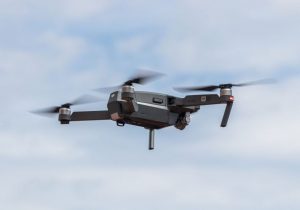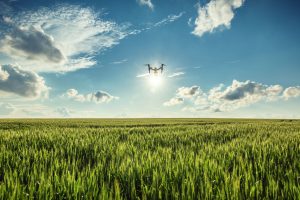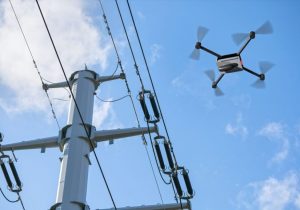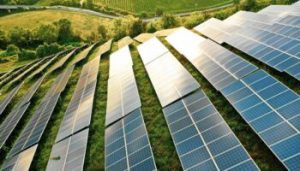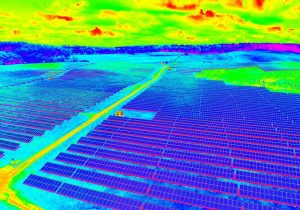Solar panel drone inspection is the latest technology that helps with the labor-intensive and hazardous job of ‘on the ground’ solar field inspection. Those in the industry know just how many man hours (days even) it can take to use handheld equipment. Not to mention, the dangerous situations technicians must endure during the long process. There is a better way, call a solar panel inspection company like Drones Cyber Security. Take advantage of our infrared drone technology for your next solar panel inspection.

Solar Panel Drone Inspection – The Better Way to Revolutionize Your Inspection Process
To achieve the most benefits from your solar panels, it is crucial to have them inspected on a regular basis. Regular thermal imaging inspections will help to ensure the safety and effectiveness of your solar panel systems. To lessen the burden on you and to have access to valuable information that is not available through more traditional inspection methods, consider using a professional solar panel inspection company for the job.
Solar panel drone inspection solutions from Drones Cyber Security make it possible to quickly inspect large geographic areas. Compared to traditional solar panel inspection methods, we’re able to pinpoint solar panel problems from the air.
We can help you locate potential issues before a major failure occurs. In other words, save time and money by keeping photovoltaic (PV) fields performing at peak efficiency.
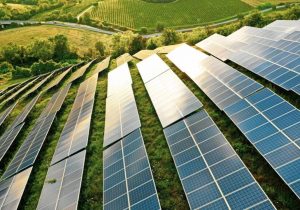
Why Solar Panel Inspections Are Crucial for Your Business
Growth is expected to continue in the solar industry, which means that there will be an increase in the use of solar installations in a variety of industries and businesses. The failure-free operation of the solar panels is necessary for longevity and efficiency. But most importantly, a good return on investment.
Solar panels need to be inspected on a regular basis. Drone solar panel inspections can provide you with many insights. As a result, you can prevent a decrease in energy production, or worse, a fire hazard.
Drones Cyber Security Solar Panel Drone Inspection Provides Aerial Solutions to Save Time and Money
At Drones Cyber Security, our experienced pilots perform aerial drone inspections for solar panels, towers, wind turbiens and more. Drones allow us to collect images and footage from multiple vantage points during the inspection process. This type of aerial inspection gives you an extremely close look at your preferred point. Once the inspection is complete, we will provide you with high-definition media that can be used to assess any solar panel issues.
Working with a solar panel inspection company offers a variety of benefits for companies with solar panels. Here are some of the reasons why it is beneficial to work with a solar panel inspection company like Drones Cyber Security.
Benefits of Working with Drones Cyber Security
- Quickly gather the output and efficiency of your solar panel array using detailed data from infrared drone imagery
- Aerial solar panel inspections with high-tech drones with a thermal camera can perform inspections of the property and installed solar panels during normal business operation without disruption.
- Solar panel drone inspection scans of PV systems identify individual module and string failures, which allows these damaged panels to be replaced earlier, which ideally is within the manufacturers’ warranty to save you money.
- An immediate return on your investment is what you will see when you boost the operating efficiency of your solar fields using drone thermography.
- Safety is also a concern in any business and thankfully, the use of solar panel drone inspection decreases the risk of employee injuries.
Solar Panel Inspection in Ontario from Drones Cyber Security
At Drones Cyber Security, our experienced pilots use state-of-the-art technology to perform aerial solar panel inspections for a variety of different locations. Our solar panel inspection company can help you save time and money by increasing the efficiency of your solar panel inspections. Contact Drones Cyber Security today to schedule your solar panel drone inspection to increase your efficiency and revenue.
Wet insulation can cause many building problems, from structural integrity damage to issues of energy efficiency and occupant health. Wet insulation is often in contact with steel structural members in commercial buildings. Structural damage occurs from rusted steel studs, corroded wall ties, and screws that hold the ties being continually wet. “Over time, loosened ties result in excess movement, which leads to cracked and discolored wall surfaces; in the worst cases, it even leads to partial collapse of veneer wall systems,” says Ried Artis, public relations leader for Owens Corning’s building materials group.
Loss of thermal performance is another consequence. If insulation is wet it becomes a conductor of energy. When insulation conducts energy rather than reflects it, it results in higher heating or cooling bills. In winter for example, heat rises from the heaters; that heat goes through the ceiling of the roof and you lose that energy. If you have insulation on the top, the heat reflects back down so you’re conserving energy.
Moisture caused by wet insulation contributes to mold. Mold needs mold spores, a food source, adequate temperature, and moisture to thrive; water is often the only element that can be controlled. If we control and limit water in the wall by using good design, good construction, and good maintenance, there’s a decent chance of controlling mold growth.
Consequences of Wet Insulation
- Roof leaks can cause costly interior damage to facilities and create hazardous conditions for building occupants.
- Wet insulation becomes a conductor of energy rather than a resister, resulting in increased energy bills.
- Trapped moisture in insulation is a great place for mold to thrive and may eventually lead to indoor air quality issues.
- Wet insulation often causes roofing fasteners to corrode and reduces the performance of the roof.
- Trapped moisture can accelerate the deterioration of the building’s structural integrity.
- Wet insulation will degrade the roofing system.
- Wet insulation adds unnecessary weight to the building.
Radiation Cooling
Everything radiates heat. The ground, for example, emits heat continuously to outer space while receiving energy from the sun. In the daytime, incoming solar energy exceeds the outgoing energy and the temperature of the ground surface rises. During the day, the sun emits energy onto the roof and into the roof substrate of buildings. At night, as there is no incoming solar energy and the ground continues to radiate away heat, its temperature falls. At night, the building roof radiates the heat back into space. This is called radiation cooling. Areas of the roof that are of a higher mass (wet) retain this heat longer than that of the lower mass (dry) areas. Infrared imagers can detect this heat and “see” the warmer, higher mass areas, during the “window” of uneven heat dissipation.
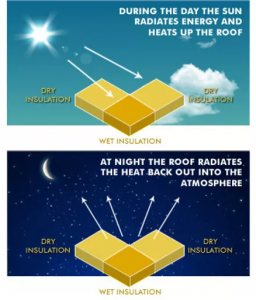
Infrared Thermography
Infrared Thermography, also known as an IR scan, is a non-destructive test method to detect and record temperature differences across the surface of an object. IR scans are the most common moisture detection method for identifying wet insulation on commercial roofing systems. During the day, wet insulation will absorb much more heat energy than dry insulation. At night, this heat is retained in the wet insulation longer and is released slower into the atmosphere. Most IR scans are done after sunset in order to capture this thermal signature of wet insulation trapped in a roofing system.
Solutions
There is a recognized three-stage approach to prevent wet insulation.
Stage No. 1: Design. When constructing a new building or remodeling an existing building, make sure it’s designed with attention to potential flaws and moisture sources. Specify insulation materials that are moisture resistant and control thermal bridging and condensation locations.
Stage No. 2: Construction. Pay attention to details. Inspect, verify, and manage latent moisture throughout construction.
Stage No. 3: Maintenance. Use qualified professionals and establish an annual routine inspection for copings at the top of parapet walls, visible flashings, lintels over windows, and control joint seals in masonry walls. Inspect for internal clues of moisture (peeling finishes or discoloration in walls or floors). Unfortunately, water in insulation or wall systems is often not visible until it has already done damage. Wet drywall may not be noticed until discoloration and mold set in. Once those things appear, repair work may be very extensive. Including a drone and aerial thermal imaging in your preventative maintenance program will help you avoid costly repairs by identifying wet insulation that cannot otherwise be seen.
Knowing the sources, identifying the problems, and finding the solutions are all important to keep your insulation dry.

